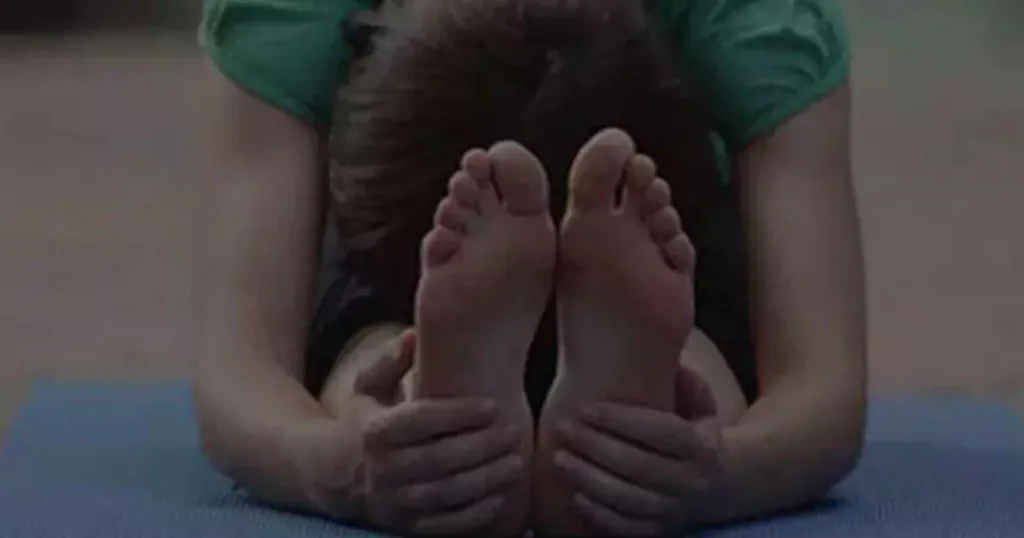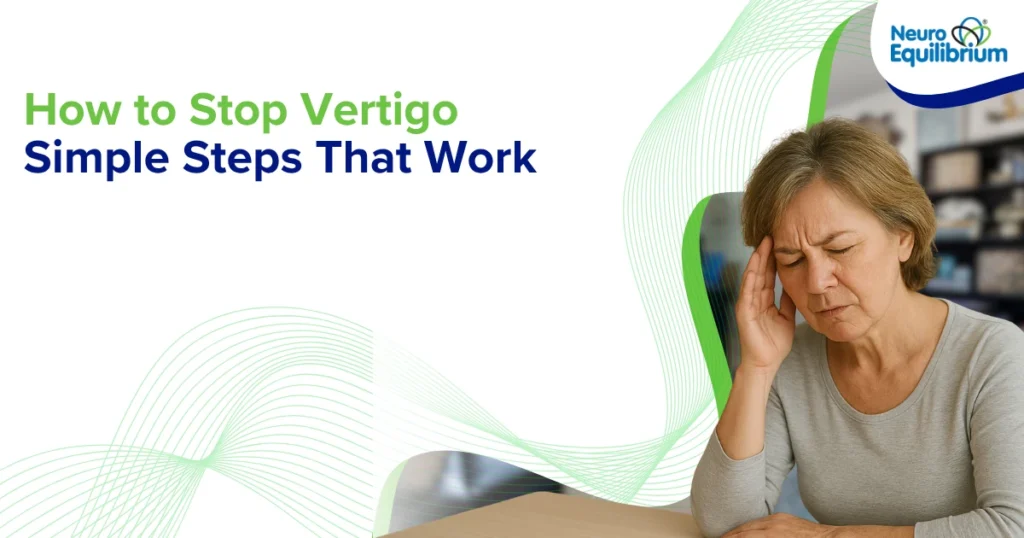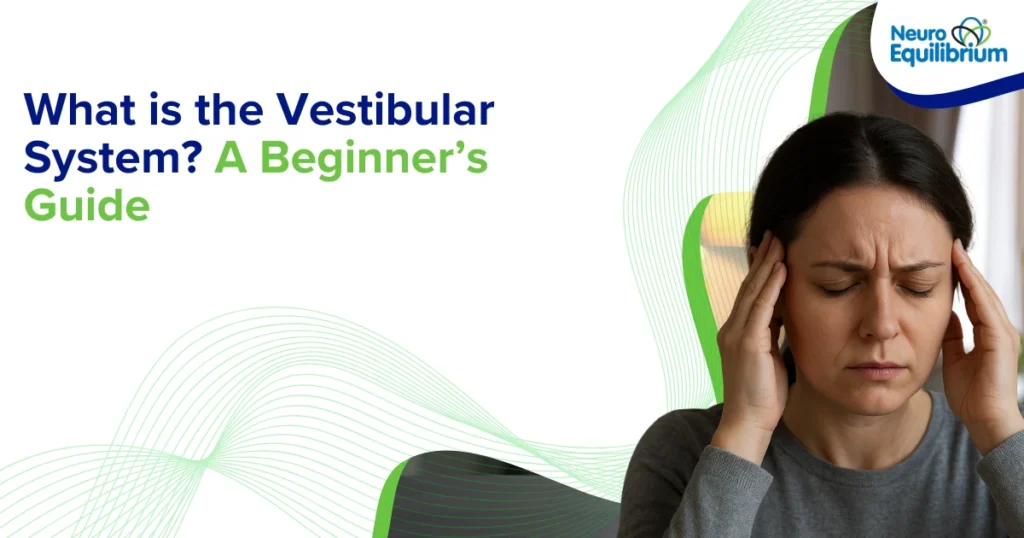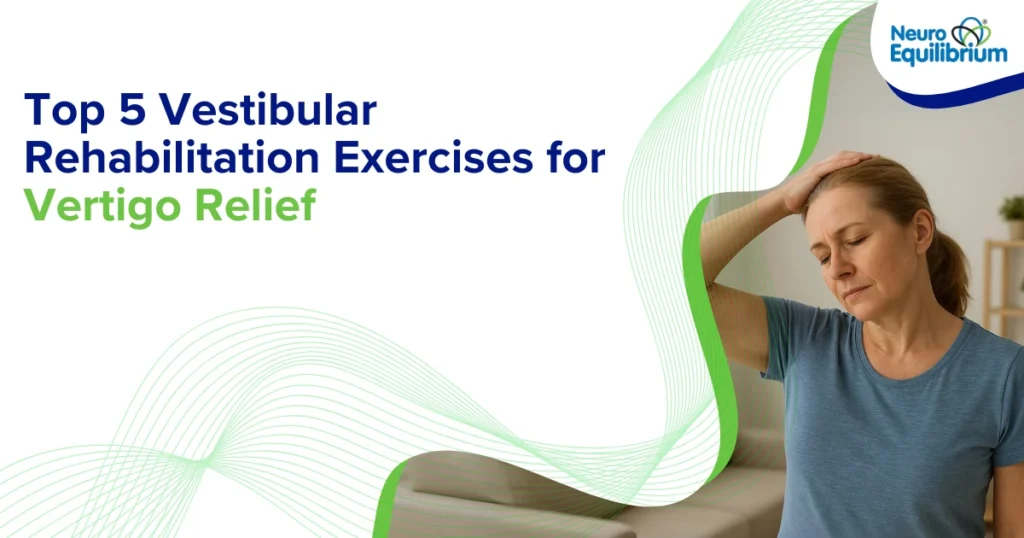Exercise or vestibular rehabilitation is an important part of the treatment of vestibular disorders. These vertigo exercises and vestibular exercises help reduce the dizziness and aid to regain balance.
The vestibular or inner ear function helps maintain our body equilibrium when still or in motion, controlling our position and helping us work against gravitational force. The vestibular region comprises of nerves, hair cells, calcium particles and fluid. Every element works in tandem with each other to recognise the body’s kinetic position with regards to gravity and balance the body accordingly.
Eyes (Visual), Ear (Vestibular) and Legs (Musculoskeletal) contribute & send the sensory information about body’s position to the brain and maintain equilibrium. The vestibular is closely connected to the eyes. Vestibular-Ocular Reflex (VOR) carries out the essential function to stabilise the eye movements and helps maintain stable vision when our head moves in different directions. On the contrary defective VOR triggers, tremors in the eyes called nystagmus. Nystagmus is sign of dizziness or balance disorders.
Infection, inflammation, or other functional disturbances can cause the vestibular disorder, which is manifest as vertigo or dizziness. These inner ear problems are treatable through medication, vertigo exercises, vestibular exercises, vertigo treatment at home, and medical procedures according to the underlying cause.
Physical therapies and vestibular exercises are popular to treat vertigo due to their effectiveness in bringing relief to the vertigo patients. The vertigo exercises help strengthen the weakened system and train the central nervous system to develop alternate strategies to deal with imbalance.
Here are some of the useful vertigo exercises to treat vestibular disorders
The vertigo exercises help stabilise the vestibular-ocular reflex and lead to the harmonised working of visual and vestibular systems. Whenever we move our head, the inner ear (vestibular region) tries to understand the relative position and help stabilize the image on the retina. The purpose of these vertigo exercises is to improve the vestibular function and help maintain the body equilibrium.
Step 1: Fix your gaze on a point (or an object, whichever is easy for you) at a distance
Step 2: Slowly move your head sideways, without moving your gaze from the point/object
Step 3: Do sideways movement of head in 3 reiterations and rest for 1-2 minutes
Step 4: Start by slowly moving your head up and down while looking at the point/object
Step 5: Do up & down movement of head in 3 reiterations and rest for 1-2 minutes
Regular work-out of vestibular exercises and vestibular-ocular muscles help recover the balance mechanism in the vestibular system. Starting from exercising on alternate days, you can go up to doing them twice daily. Don’t rush through the vertigo exercises. Let your body decide the frequency of workouts. Sometimes, when you start, you will feel dizzy, in such cases, stop exercising and rest adequately. You can restart the vertigo exercises once you feel comfortable again.
- Make sure you do these exercises while sitting or ensure someone’s presence in the room to hold you just in case you feel dizzy and lose your balance.
- Steer clear of dangerous objects, or places when exercising.
The above exercise is called gaze stabilisation. It is one of the many other VOR vertigo exercises and vestibular exercises done to recalibrate the visual, vestibular and central nervous system. These are relatively simple activities yet are notably effective vestibular rehabilitation therapies and a useful part of vertigo treatment at home.
As you progress through the vertigo exercises with less difficulty and fewer episodes of vertigo, your therapist may advise you to do the vertigo exercises standing or walking. You should not do these vestibular exercises unmanned, as there are chances of drop attacks during exercising.
The therapists at NeuroEquilibrium’s advanced vertigo and balance clinics, conduct these vertigo exercises on highly sophisticated equipment that enable them to monitor and measure the results and improvements on sound medical data. Although doing vestibular exercises and vertigo treatment at home is comfortable, real evaluation is possible only at clinics. Seeing your progress and comfort level, the therapist may suggest you continue these vertigo exercises at home and come in for the assessment at regular periods.
Safety Guidelines & Symptom Management During Vestibular Exercises
- Follow the “2‑Point Rule” for Symptom Intensity: It’s normal to experience mild dizziness during exercises—this helps retrain the brain. Aim for a symptom increase of no more than 2 points above your baseline (on a 0–10 scale), and allow full recovery within ~15 minutes post-session. If it takes longer or symptoms exceed this threshold, reduce the intensity or try a gentler variation.
- Progress Gradually & Tailor to Triggers: Start slowly—incorporate head turns or visual motion in levels you can tolerate, and increase only as you feel ready. If certain movements spike symptoms, lower the speed, shorten duration, or reduce repetitions.
- Maintain a Supportive Environment: Always exercise in a safe space: clear potential hazards, ensure good lighting, and have a sturdy chair or wall nearby. For standing or walking versions, cling close to a surface or have someone present for support.
- Take Regular Breaks & Rest After Each Session: Schedule your routine (e.g., 3–6 sessions daily) but include rest afterwards. If dizziness or nausea doesn’t subside within 10–15 minutes, pause and allow full recovery before resuming.
- Monitor & Record Your Symptoms: Keep a log of intensity levels, duration, and recovery time. Use it to track progress and report any prolonged or worsening symptoms to your therapist or doctor.
- Don’t Exercise When Ill or Overtired: Avoid your exercises if you’re feeling unwell or excessively fatigued, as this may exacerbate symptoms and delay recovery.
- Know When to Stop & Seek Professional Input: Discontinue exercises and see a clinician if your symptoms persist beyond normal recovery, if new symptoms (e.g., ear fullness, hearing changes, severe imbalance) occur, or if you plateau despite consistent effort.
Explore More About Vestibular Disorders:
Check for the appointment and therapy here.
Exercises:
1. Canalith Repositioning Manoeuvres (for BPPV)
Canalith repositioning manoeuvres are targeted treatments for BPPV, a common form of vertigo caused by displaced calcium carbonate crystals in the inner ear. These manoeuvres are highly specific and based on the location of the crystals, which are identified using diagnostic tests that track involuntary eye movements (nystagmus). Movements like the Epley or Semont manoeuvre are designed to shift the crystals out of the semicircular canals and back into the utricle, where they no longer cause symptoms. When performed accurately, these techniques can provide immediate relief, often resolving symptoms in a single session. Advanced clinical tools have been developed to help guide these movements, ensuring proper head angles and improving success rates.
2. Vestibular Rehabilitation Therapy (VRT)
Vestibular Rehabilitation Therapy (VRT) is a structured program of exercises designed to strengthen the brain’s ability to compensate for inner ear dysfunction. It is particularly useful in managing long-term balance issues caused by vestibular nerve damage or after infections like labyrinthitis. Traditional VRT includes exercises that involve repeated head movements and balance tasks, helping the brain re-learn how to interpret motion and spatial orientation. With technological advances, VRT is now offered through mobile apps or immersive VR/AR environments that simulate real-world scenarios such as walking on uneven surfaces or navigating crowded spaces. These methods not only increase patient engagement but also gradually desensitise individuals to motion sensitivity, ultimately restoring confidence and function.
3. General Exercise and Physical Activity
Beyond specific rehabilitation techniques, general physical activity plays a vital role in managing vertigo and promoting long-term health. Exercises like walking, swimming, or Tai Chi help improve muscle strength, coordination, and proprioception the body’s awareness of its position in space. These activities are particularly beneficial for older adults, who are at a higher risk of falls due to balance issues. In some cases
Vertigo Exercises at a Glance
Vertigo exercises are a cornerstone of vestibular rehabilitation therapy. They involve specific head, eye, and body movements that retrain the brain and balance system to adapt to abnormal signals from the inner ear. Unlike medications, which only mask symptoms, exercises work by addressing the root cause of dizziness and teaching the body to recalibrate.
What They Are
- Targeted maneuvers designed to reposition displaced crystals in the inner ear.
- Rehabilitation routines that retrain the eye–head coordination and balance responses.
- Postural control strategies that reduce the risk of falls and improve confidence in movement.
Purpose
The main goal is to reduce dizziness and improve stability. Exercises can help lessen vertigo episodes, shorten their duration, and restore balance in daily activities.
Conditions Helped
These routines are especially effective for:
- Benign Paroxysmal Positional Vertigo (BPPV) – crystal-related dizziness.
- Vestibular neuritis – imbalance following inner-ear nerve inflammation.
- Ménière’s disease – when episodes are mild and linked to inner-ear dysfunction.
Process
Most exercises are safe, non-invasive, and often performed at home. A doctor or physical therapist usually demonstrates the correct method first, and patients continue them regularly for best results.
How Vertigo Exercises Work
The problem of vertigo occurs when the brain obtains conflicting information on body position and movement. The objective of exercises is to reestablish the balance between the brain, inner ear and the eyes.
- Otolith movement:- Otolith movement Maneuvers like the Epley foster aid crystals (otoconia) back to where they belong in the inner ear.
- Problems coordinating eye and head movements – Cawthorne-Cooksey routines and gaze-stability exercises retrain the nervous system to provide more fluent balance responses.
- Recurrent dizziness exercises stimulate vestibular compensation by repeatedly exposing the brain to conflicting balance signals, training it to gradually adapt and ignore the faulty inputs, which in turn reduces vertigo symptoms.
The NIH and PubMed research results confirm that exercise regimes have a high level of success in enhancing postural stability and lowering the recurrence of vertigo in patients with vestibular disorders.
When to See a Doctor Before Doing Exercises
Despite the fact that vertigo exercises are usually harmless, certain symptoms should be considered dangerous and should be considered prior to commencing them:
- Headache or weakness with sudden and severe dizziness.
- Dulling or blurred speech, or drooping of the face – potential stroke symptoms.
- Constant falls or continuous loss of balance that disrupts day-to-day safety.
- No improvement in 2-3 weeks of regular exercises at home.
When you have any of these red flags, see an ENT or neurologist as soon as possible to exclude other more severe causes.
















